Why is Skills Based Hiring Gaining More Popular? [Complete Guide]

A growing number of companies are turning to skills based hiring to solve talent gaps and focus on real ability instead of long resumes. This approach helps teams spot candidates who can perform in practical situations. In this guide, MOR Software will explain why this method is becoming essential and how it supports stronger, more reliable hiring decisions.
What Is Skills Based Hiring?
Skills based hiring starts from a clear idea. Employers look at what a person can do instead of focusing on degrees or long work histories. This approach highlights real abilities and job tasks. It moves attention away from old hiring habits that depend too much on titles or past roles. It uses tests and short tasks to check if someone has the right skill level for the job and can handle daily work in a real setting.
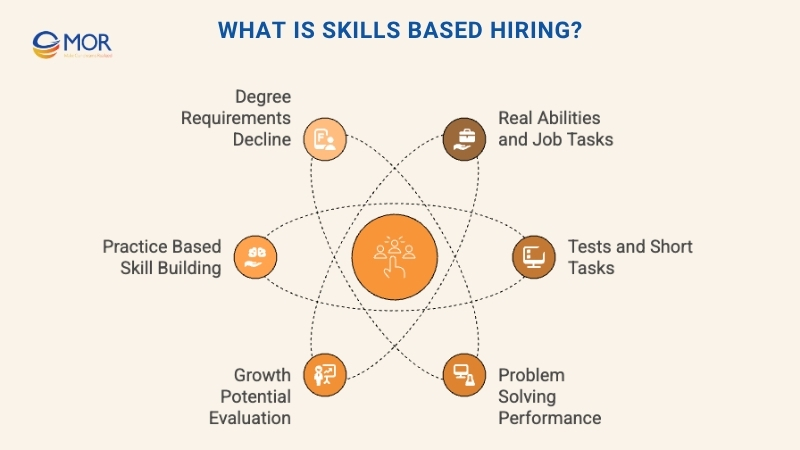
This way of choosing talent puts real performance first. It looks at how someone solves problems or completes key tasks. It helps companies see whether a person can grow in the role, not just if they have a formal qualification. It also gives more chances to people who learned skills through practice or personal study.
Between 2014 and 2023, companies dropped degree requirements for many roles. The number of these jobs went up almost four times in that period, with the highest point in 2022.
>>> The demand for top talent is surging, with companies hiring across every sector at record speed. Let's explore the top players and where leading cloud computing company in product development remote and onsite roles are growing.
What Are The Key Features Of Skills Based Hiring?
Skill-based hiring uses clear steps to help companies focus on ability. It is also linked to competency based hiring, which looks at real work tasks instead of long resumes.
- Skills first focus: This approach checks if a person can complete job tasks well. It reduces the weight of degrees or long experience and puts attention on real performance.
- Skills assessment tools: Companies use tools like short tests, video interviews, game style tasks, situational tests, and assessment centers. These activities show how someone reacts to real work situations and how they solve problems.
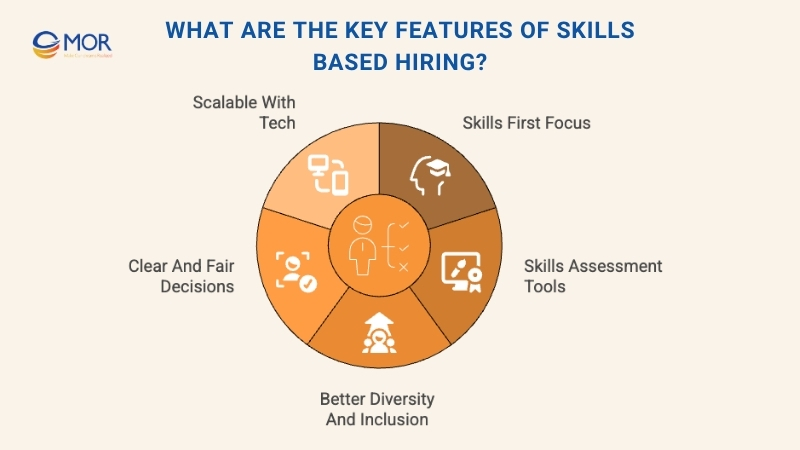
- Better diversity and inclusion: When strict degree rules are removed, more people can apply. This helps include self taught talent, freelancers, and people who change careers.
- Clear and fair decisions: The results from these tests give objective data. Companies gain a simple view of a person’s ability and can make bias free choices.
- Scalable with tech: Modern HRM models help teams check many candidates at one time. These tools keep the process fair, fast, and consistent. They also support skill-based hiring solutions with analytics to strengthen accuracy.
Next, we look at how this method differs from traditional hiring.
How Is Skills Based Hiring Different From Traditional Hiring?
Skills based hiring focuses on a person’s real ability to do the job. It looks at hands on tasks, simple tests, and short activities that show how someone performs. This approach cares about what a person can do in daily work, not only what appears on a resume. Traditional hiring depends more on degrees, past job titles, and long work experience as signs of future success. It follows old patterns instead of checking real skill levels. The new method is more based on skills, while the older style relies heavily on credentials.
Below, we outline the main differences between the two hiring styles.
Key Differences Between Skills Based Hiring And Traditional Hiring
Aspect | Skills Based Hiring | Traditional Hiring |
Primary Focus | Checks specific skills and tasks to understand real job performance. | Focuses on degrees, past roles, and long experience. |
Candidate Pool | Open to self taught talent, freelancers, and people who change careers. | Limited to people who match degree or experience rules. |
Assessment Methods | Uses tests, personality tools, video calls, game style tasks, coding checks, situational tests, and task simulations. | Uses resumes, cover letters, and standard interviews. |
Bias Reduction | Lowers bias through clear and measurable results. | Risk of bias linked to school names or job titles. |
Workforce Diversity | Encourages talent with different learning paths. | May block people without formal qualifications. |
Speed of Hiring | Often faster because simple automated checks help filter strong talent. | Slower because teams must review many documents. |
Retention and Performance | People hired through skills testing often stay longer and match job needs. | Candidates chosen mainly through degrees may not fit well, which increases turnover. |
The Rise Of Skills Based Hiring
Historically, employers placed strong weight on college degrees, certifications, and work experience as the main filters for hiring. In the early 2000s, many organizations started to see clear limits in this old model.
- The Growing Skills Gap: As tech industries moved fast, employers saw that formal schooling often did not give people the practical skills needed for real jobs. A degree showed basic knowledge, but it did not always match skill with tools, software, or day to day industry tasks.
- The Push For Workforce Inclusion: Traditional hiring often shut out skilled people without degrees or those from underrepresented groups. During the 2010s, leading companies like IBM introduced new programs that looked at practical ability, showing that many strong candidates did not fit the usual pattern.
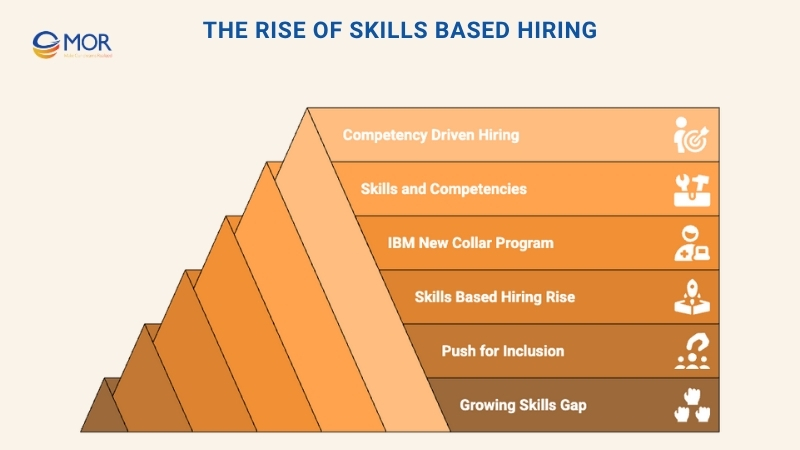
Today, skills based hiring is on the rise and has moved from a small trend into a new hiring standard. As industries change and job tasks grow more specific, employers continue to review old hiring habits that focus too much on degrees and job titles instead of clear ability. This shift also connects well with skills-based hiring news that highlights new and growing interest in this approach.
Case Study: IBM’s “New Collar” program, which started in 2016, aimed to hire people with real skills. In three years, the company saw a 25 percent increase in talent pipeline diversity, a result that came from valuing skill over formal background.
Today, more companies focus on skills and competencies, creating hiring processes that are efficient, inclusive, and ready for the future. As competency driven hiring gains strength, more people from different paths can access good roles, while businesses gain talent that fits their changing needs.
Now that we understand how skills based hiring is growing, the next section looks at what this approach measures.
What Does A Skills Based Hiring Process Measure?
Skills based hiring looks at clear abilities that connect directly to the job. These include technical skills, problem solving strength, soft skills, and practical knowledge. It reviews what a person can do instead of using degrees or long job titles as the main filters. This helps ensure that each person has the right ability to grow in the role and support the company.
When both technical and soft skills are checked, employers can find people who are truly ready for the job. This works well even when someone does not have a traditional background or long work history.
Let us look at each main skill area in this part.
Measuring Technical Skills
Skills based recruitment checks technical skills and knowledge through activities like practical tests, simulation tasks, and portfolio checks. These tasks ask candidates to show their ability through real actions or through the use of tools, HR system integration, or software they must handle in the role.
When work tasks are tested in real situations, this method makes sure that each person has the right technical ability for roles such as software engineers, data scientists, graphic designers, and many other specialist jobs. This also supports based employment, where clear performance matters most.

What technical skills does a skills based hiring process measure? Employers can review the following common hard skills under this approach.
- Analytical Skills: The ability to collect and understand data through statistical work, data models, market study, and problem solving.
- Financial Skills: Skill in handling financial data, planning budgets, and forecasting with tools like financial models, accounting software such as QuickBooks or SAP, risk checks, and financial reports.
- Administrative Skills: Strength in handling office tasks through project tools, calendar work, data entry, and common office software.
- Mechanical Skills: Knowledge for working with machines, tools, and engineering ideas through CAD software, troubleshooting tools, machine learning setup, and maintenance tasks.
- Language Skills: Clear writing and speaking in one or more languages for communication across regions.
- Coding and Programming Skills: Ability to write and understand code for building apps, websites, or systems through many languages, development work, debugging, and version control.
- Design Skills: Skill in making visual content for online or print use with design tools, UX or UI design, font work, and prototyping.
- IT Skills: Understanding of IT systems, hardware, software, and network rules.
- Engineering Skills: Knowledge of engineering ideas and how to use them in real tasks through civil design tools, consensus mechanisms systems, and electrical problem solving.
- Marketing Skills: Knowledge of tools that help build and run marketing plans on online platforms.
- Sales Skills: Ability to grow sales and build sales plans with the support of sales tools and CRM solutions.
- Research Skills: Skill in gathering useful information for decisions through market study, academic work, competitive checks, and data collection.
Technical skills are important in a skills based hiring process. Soft skills are also important, and the next section explains how they are measured.
Measuring Soft Skills
Skill based hiring also looks at soft skills, which include personal, social, and thinking abilities. These skills shape how a person works with others, handles change, and manages daily tasks. They matter a lot in the workplace because they affect teamwork, leadership style, and how someone solves problems. This also supports hiring for skills & traits, which helps companies choose people who can adapt and grow.
Soft skills are different from technical skills because they are more abstract and harder to score with simple tests. Even so, they can still be checked through methods in skills based recruitment, such as behavior style interviews, role play tasks, cognitive ability tests, personality tests, and situational judgment tests.
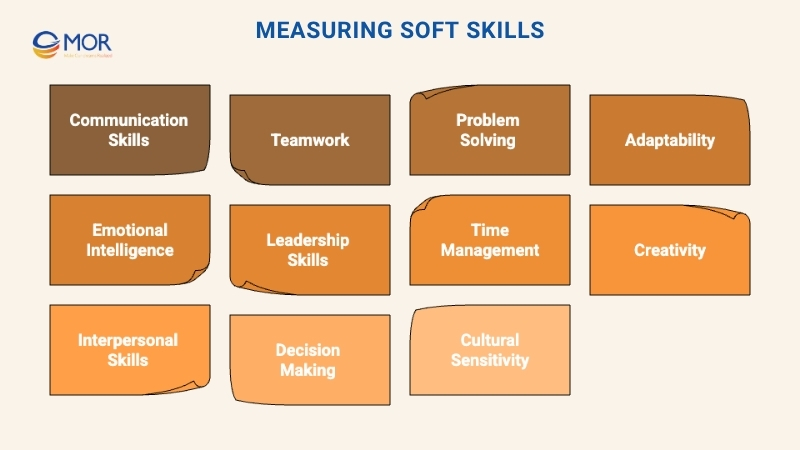
What soft skills does a skill based hiring process measure?
- Communication Skills: The skill to share ideas clearly, listen with care, and change speaking style for different people and situations.
- Teamwork and Collaboration: The skill to work well with teammates, support shared goals, and respect different views.
- Problem Solving and Critical Thinking Skills: The ability to study hard situations, think with care, and create useful solutions that support good decisions.
- Adaptability and Flexibility: The ability to adjust to new conditions, take on fresh tasks, stay strong, and face uncertain moments with a good attitude.
- Emotional Intelligence (EQ): The skill to understand and guide emotions in yourself and others to build good relationships and keep teamwork strong.
- Leadership Skills: The way you guide, encourage, and inspire people while creating a safe and productive space and managing conflict.
- Time Management: The skill to set priorities, follow deadlines, and handle workload in an effective way.
- Creativity and Innovation: The ability to think in new ways, share fresh ideas, and handle challenges with a creative mind.
- Interpersonal Skills: The skill to build positive and trusting relationships with coworkers, clients, and outside partners.
- Decision Making: The skill to choose actions with care, think about short term and long term effects, and include others when needed.
- Cultural Sensitivity: The ability to work with respect for different backgrounds, beliefs, and styles in a team or workplace.
A hiring method that values both technical and soft skills helps build a balanced team. This leads to long term success in busy and complex work settings, and it also supports fair skills based hiring practices.
Now that we have explored how soft skills are measured, we can move to the next part and learn how the full process works.
How Does Skills Based Hiring Process Work?
Skills based hiring shifts the recruitment process away from older methods and places attention on real ability. It uses clear tools and simple checks to measure what a person can actually do in the job. Recruiters use these tools at different steps in the process to review important skills that link directly to the role. This also supports skill based hiring, which helps companies focus on proven ability instead of long resumes.
The full skills based hiring model includes several main steps:
- During the first online screening step, companies use pre employment psychometric assessments such as technical tests, cognitive aptitude tests, situational judgment tools, and role based simulations. These activities help hiring teams check practical skills. Only candidates who meet the needed skill level go to the next step in the process.
- In the next stages, hiring teams use job based tasks, structured behavior interviews, and assessment center activities to learn more about the person’s skills, work style, and personality. These later steps help teams see how each person acts in real work situations.
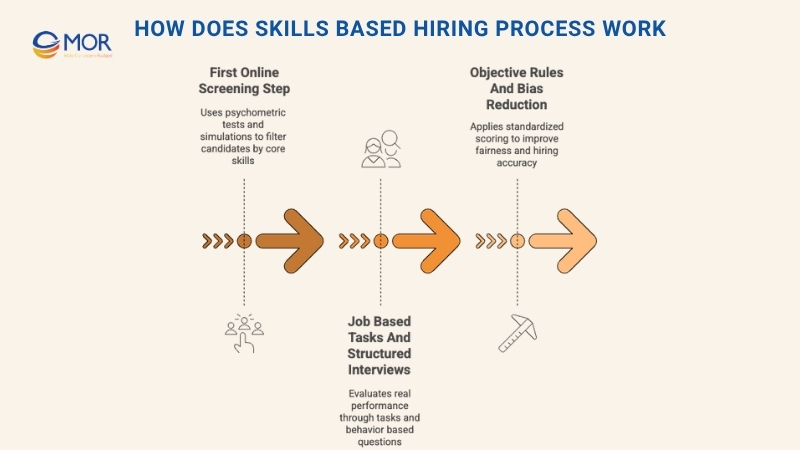
This skills based method gives strong benefits to hiring teams. Clear and objective rules make job performance easier to predict and help reduce bias in key decisions. It also opens the talent pool to people who gained skills through different paths, which helps create teams that are more diverse and qualified. This approach also helps companies react fast to new skill needs, especially in technical fields where formal education can move slowly.
We can move on to examples of this method and the assessment tools used in skills checks, since these tools support the full hire methods process.
Types Of Assessment Tools Used In Skills Based Hiring
Pre employment psychometric tools used in skills based hiring help measure skills, thinking ability, personality traits, and job related strengths in a structured way. They check abilities such as problem solving, technical knowledge, and cultural fit.
In this part, we look at the different assessment tools that employers use for a skills-based hiring assessments uk approach. These tools help teams make clearer hiring decisions, improve accuracy, lower bias, and predict job performance more effectively.
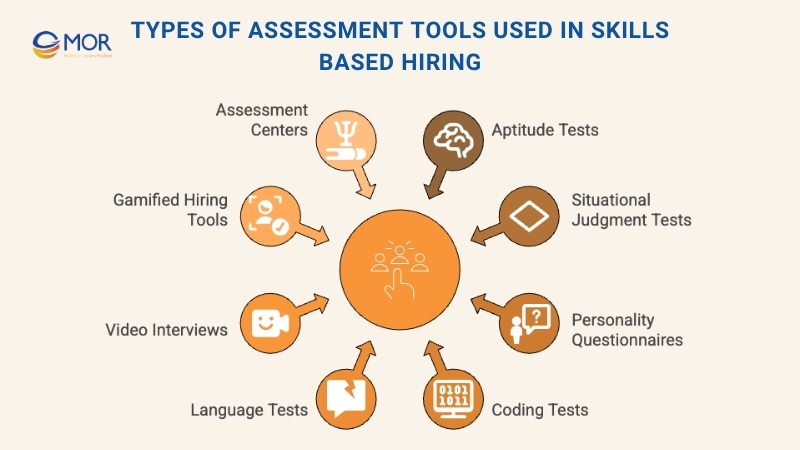
Aptitude Tests
Aptitude tests are standard psychometric tools used to measure a person’s thinking skills. These tests check different types of cognitive ability.
- Numerical Reasoning Tests: These tests check a person’s skill to read, study, and understand numerical data in charts, graphs, or tables. Numerical tasks often use simple arithmetic, ratios, percentages, and data reading.
- Logical Reasoning Tests: Logical tests measure the ability to think carefully, solve problems, and notice patterns or links to reach correct answers from given information.
- Verbal Reasoning Tests: These tests check how well someone can understand and review written content. Verbal tasks involve comprehension, logic, and critical thinking. They ask people to read text and make correct conclusions.
- Critical Reasoning Tests: Critical thinking tests review a person’s ability to study information, judge what matters, make sound choices, and solve problems using given facts.
- Abstract Reasoning Tests: These tests review a person’s skill to find patterns or links in abstract shapes or symbols without using words or extra hints.
- Error Checking Tests: These tests check the ability to find mistakes in text or data. They measure attention, accuracy, and careful working.
When companies use psychometric tests, especially ability tests, they need a trusted provider for smooth and fair assessments. A reliable platform can help teams run standard checks and review skills in a simple way. This supports skills-based workforce planning and helps companies choose the right talent through clear, structured testing.
Situational Judgment Tests
Situational judgment tests show candidates short workplace scenarios they may face in the role or within the company. Candidates must pick how they would respond and choose the action they believe is most suitable. These tests, like situational tools used on many hiring platforms, help teams review work behaviors and key strengths such as problem solving, decision making, communication, teamwork, and leadership skills.
Personality Questionnaires
Personality questionnaires study a candidate’s personality traits and work style to see how well they match the company culture and values. These tools help employers understand how a person behaves at work and how they might fit into a team.
When using skills based hiring, a personality questionnaire can give a clear and simple way to check if a candidate is a good match for the role. It can support a smooth and accurate review of job fit without adding extra stress to the process.
What are the different types of personality tests?
Personality tests come in several common types:
- The Myers Briggs Type Indicator (MBTI): The Myers Briggs Type Indicator places people into 16 personality styles in four main pairs: Extraversion (E) and Introversion (I), Sensing (S) and Intuition (N), Thinking (T) and Feeling (F), and Judging (J) and Perceiving (P). It is popular in many workplaces, though some question how well it predicts performance.
- The Hexaco Personality Inventory: The HEXACO Personality Inventory checks 6 main personality areas: Honesty Humility, Emotionality, Extraversion, Agreeableness, Conscientiousness, and Openness to Experience. It is used in studies and workplace reviews to understand behavior and workplace style.
- The Sixteen Personality Factor Questionnaire: The Sixteen Personality Factor Questionnaire measures 16 core personality traits. It is used for hiring to study traits like warmth, logic, and emotional awareness.
- DISC Assessment: The DISC tool reviews 4 key traits: Dominance, Influence, Steadiness, and Conscientiousness. It is common in companies to support teamwork, communication, and work quality.
- Keirsey Temperament Sorter: The Keirsey Temperament Sorter places people into 4 main temperaments: Artisan, Guardian, Idealist, and Rational. It is useful for team understanding and personal growth, though it has limited research support for hiring choices.
- Caliper Profile: The Caliper Profile studies personality traits and work motivations to predict job performance. Many companies use it to check if a candidate suits a certain role.
- The Big Five Personality Inventory: The Big Five Personality Test checks the five major personality traits: Neuroticism, Extraversion, Openness, Agreeableness, and Conscientiousness. It is widely used in hiring to understand personality and possible fit in a company.
Coding Assessments
Coding tests measure a candidate’s programming skills and their ability to handle technical problems through code. These tests often look at problem solving, algorithm thinking, software building, and skill with programming languages such as Python, Java, or C plus plus.
Language Proficiency Tests
Language tests check a candidate’s skill in reading, writing, and speaking in a specific language. These tests are used for roles that rely on strong communication, such as customer support or content work in different regions. They help ensure the candidate can communicate well with clients or team members.
Video and Two-Way Interviews
Video interviews give employers a way to review candidates from a distance through live sessions or recorded one way videos. These interviews help teams study verbal and non verbal signs to understand skills, communication, problem solving, and cultural fit. Many recruiters also use AI powered video interviews to make the hiring process smoother, remove travel limits, and focus on real work ability. This makes video interviews a strong fit for skills based hiring.
Here are the 5 key benefits of using video interviews in skills based hiring:
- Standardized Evaluation: Structured video interviews use set questions so every person is checked with the same rules. This helps lower bias and improves fairness.
- Skill Demonstration: These interviews let employers ask candidates to solve tasks, explain their process, or show specific skills in real time. This gives a clear view of their ability.
- Asynchronous Convenience: One way video interviews let candidates record answers when it suits them. This makes the process easier for both sides.
- Enhanced Accessibility: Video interviews open the talent pool because people can join from any location. This helps companies reach more diverse applicants.
- Cost and Time Efficiency: Virtual interviews cut travel costs and reduce scheduling time. They help speed up the first round of screening.
- Two Way Interviews: Two way interviews are open conversations where employers and candidates talk about skills, past work, behavior, goals, and job expectations. This style supports better understanding, checks job ability, and helps confirm a good match between both sides.
To check skills effectively through this method, use the following steps:
- Use Behavioral and Situational Questions: Ask questions that make candidates think about past experiences or explain how they would face key work challenges. For example: “Can you describe a time when you had to solve a complex problem under tight deadlines? What was your approach?” or “How would you handle a situation where a project’s requirements change mid way?”
- Role Specific Scenarios and Simulations: Share role based situations that feel close to real challenges. For example, when using skill based hiring for a marketing role, you might ask the person to create a short plan for a campaign for a new audience. This helps confirm if they have the right skills for the job.
Gamified Hiring Tools
Game based assessments mix testing with game style elements to measure thinking skills, decision making, emotional awareness, memory, and problem solving. This modern approach helps employers check ability in a simple and engaging way. It also keeps candidates interested during the process. When using skills based hiring, many teams choose game based assessments to support a positive and smooth candidate experience with candidate relationship management.
Assessment Centers
Assessment centers are structured settings where candidates join several tasks, tests, and simulations to review their skills, strengths, and fit for a role. These sessions often include individual tasks, group work, presentations, role play activities, and psychometric tests.
Skill verification platforms also help check real world ability through practical tasks, digital badges, and industry certificates. These tools focus on skills first instead of formal credentials.
After looking at the main tools used in skills based hiring, we can now explore the clear benefits this approach gives to organizations.
Why Are Employers Adopting Skills Based Hiring Methods?
Skills based hiring is creating real change for companies that want to improve their diversity and adjust to fast changing job needs. Many employers now see the strong value of this method. When teams look at a person’s real ability and potential, this hiring style helps companies find and keep the right people. It also supports a workplace that feels more open, active, and fair. This fits well with advantages of skills-based hiring uk, which many global teams follow when building stronger talent groups.
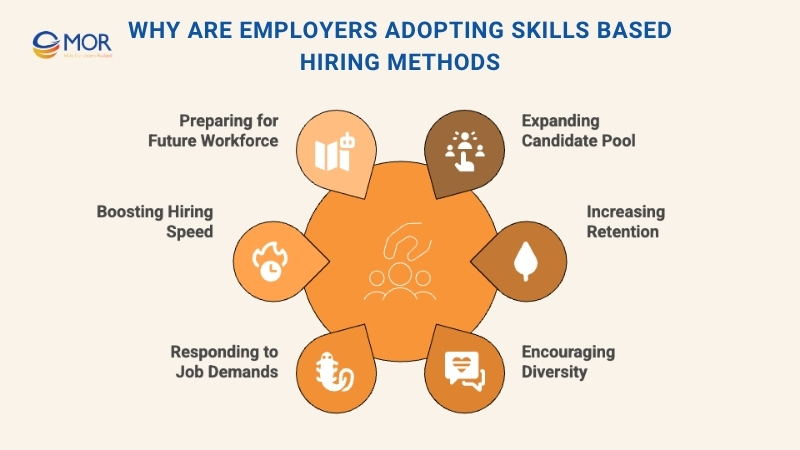
Below are 6 key benefits that companies gain from this approach.
Expanding The Candidate Pool
Skills based hiring helps companies reach a much wider group of applicants because it removes strict rules like degree requirements or fixed job titles. This method gives space to people who built useful skills through online study, short courses, or self learning. It also supports non traditional paths that still lead to strong ability.
In many tech teams, for example, real coding skill and problem solving can matter more than a formal computer science degree.
Research from the Burning Glass Institute and Harvard Business School shows that skills based hiring raises candidate pools by 20 percent to 30 percent, which gives employers more chances to find qualified people.
Increasing Retention And Job Success
Skills based hiring helps employees perform better and stay engaged in their roles. This leads to lower turnover and supports long term stability for the company.
For example, a customer service applicant with strong communication skills and empathy can do well in handling client issues, even if they have not held a customer service role before. With tools like behavior based interviews or situational judgment tests, employers can check these abilities clearly.
Research from Boston Consulting Group shows that employees hired through skills based methods stay 9 percent longer, which reflects better satisfaction and stronger stability.
Encouraging Workplace Diversity
Skills based hiring helps reduce bias because it focuses on what candidates can do, not where they studied or worked before. Traditional hiring often blocks people from underrepresented groups due to gaps in education or past job titles.
For example, a marketing firm may choose candidates with strong social media skills, SEO knowledge, and AI content strategy even if they do not hold a formal marketing degree.
Reports show that 90 percent of employers saw better workplace diversity after using skills based hiring practices, according to TestGorilla.
Responding To Changing Job Demands
Skills based hiring gives more weight to adaptable skills instead of fixed qualifications. As new technology grows fast and jobs need a mix of hard skills and soft skills, a traditional resume often cannot show a person’s full ability.
The World Economic Forum shares that 50 percent of workers will need reskilling by 2025 to keep up with changing job needs.
Boosting Hiring Speed And Accuracy
Skills based hiring helps make the hiring process smoother through clear assessments that check candidates early. This approach reduces the time spent on resume checks and long interview rounds. Tools like pre employment tests, game style assessments, and AI supported interviews make it faster and easier to find strong talent.
Reports show that 81 percent of organizations using skills based hiring lowered their time to hire, and 78 percent reduced hiring costs, according to TestGorilla.
Preparing For The Future Workforce
Skills based hiring helps companies adjust to fast changing technology because it focuses on a person’s ability to handle tasks that match current technological needs. This approach lets employers fill roles that need new or specialized skills, keeping their teams updated with modern tools. This style of hiring also supports ongoing learning, since employees are encouraged to keep their skills fresh.
For example, companies such as IBM have removed degree requirements for many positions and now look mainly at hands on skills in areas like cloud systems and AI automation services. This change shows the wider move toward valuing real ability over formal qualifications.
LinkedIn’s 2024 Workforce Report found that 75 percent of HR leaders believe that skills based hiring will guide the future of recruitment.
What Are The Main Challenges In Implementing Skills Based Hiring?
Skills based recruitment is reshaping how companies hire, but every approach has its own limits. This method also brings challenges that may affect results if they are not handled well. With the right talent strategies, companies can reduce these problems and keep the process effective.
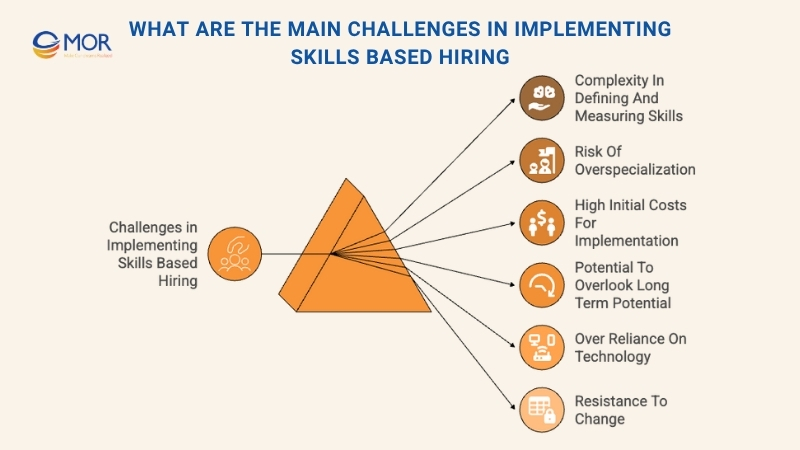
Below are the 6 main challenges companies face when using skills based hiring and ways to solve them.
Complexity In Defining And Measuring Skills
Most roles need both technical skills and soft skills, which makes it hard to choose and measure the right mix for each job. The process can become complex and may take a lot of time. For example, technical skills like coding can be checked with simple programming tasks, but it is harder to measure soft skills such as adaptability or leadership with the same tools.
LinkedIn Workforce Report shows that 91 percent of talent experts believe clear skill lists are important for good hiring, yet 41 percent of companies still struggle to define them.
Solution: Create a full job study to list the key skills and main competencies for the role. After that, choose the right assessments that match what you want to measure. You can also work with subject matter experts to build accurate and reliable criteria.
Risk Of Overspecialization
Skills based hiring can sometimes lead to choosing candidates who perform very well in one area but lack the ability to adjust when job needs change. This can create a team that is less flexible in fast moving industries. For example, someone hired for skill in one software tool may face challenges when the company moves to new systems or processes.
Solution: To lower the chance of overspecialization in a skills based hiring process, include learning agility checks to review how well candidates can grow. Look at related skills and long term potential, not only current strengths.
High Initial Costs For Implementation
A skills based hiring model often needs investment in tools, training, and technology. Companies must buy assessment platforms, train HR teams, and build custom tests for different roles, which can raise costs. Advanced tools like AI supported interview systems or game style assessments may also stretch the budget, especially for small firms or startups.
Solution: Choose scalable and cost friendly platforms that fit both small and large teams. A subscription or flat fee service can help lower the cost per candidate. Using tools such as pre employment testing, game based assessments, and video interviews can help companies start a skill based hiring plan without heavy spending.
Potential To Overlook Long Term Potential
Focusing too much on present day skills can cause teams to miss candidates who have strong growth ability. Someone who is not fully skilled in one area today might still learn fast and perform well later, but they could be removed from the process too early.
Solution: Add aptitude checks and learning potential tests to the hiring steps. This helps you find candidates who show promise, can grow into the role, and are able to learn the required skills.
Over Reliance On Technology
Heavy use of AI systems, ATS tools, or automated assessments can sometimes cause mistakes or missed details. Research from Harvard Business Review shows that 88 percent of companies using AI in hiring saw better efficiency, but 37 percent also had concerns about bias.
Solution: Use human review along with technology. This helps check results more carefully and captures important details about each candidate.
Resistance To Change
Moving from traditional hiring habits to modern methods like skills based hiring can be difficult, and some hiring managers or HR teams may push back against the shift.
Solution: Run training sessions to help teams understand the benefits and best practices of a skills based approach. It also helps to slowly reduce older methods and bring in skills focused steps over time.
Beyond filling open roles, skills based hiring supports a more inclusive workplace. This method helps remove barriers and promotes workplace diversity.
How Does Skills Based Hiring Improve Diversity And Inclusion?
Skills based hiring is now a key method for companies that want to build diverse and inclusive workplaces. This approach looks at real skills and proven ability instead of credentials, which gives chances to people from many different backgrounds who might be missed in traditional hiring. It places attention on what a person can do instead of where they studied or what title they hold. This creates a more equitable and open hiring process.
In this section, we explore how skills based hiring can strongly improve workforce diversity.
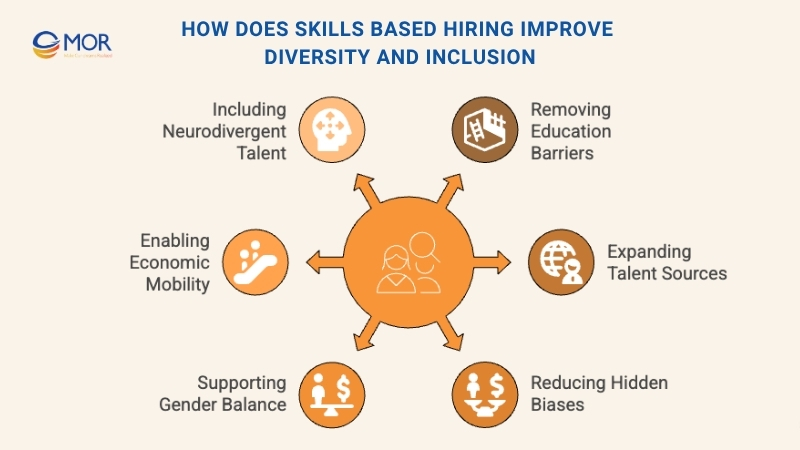
Forbes reports that diverse teams deliver 60 percent better results and make stronger decisions in 87 percent of cases.
Removing Education Barriers
Traditional hiring often favors degrees from certain schools, which can unintentionally exclude people from underrepresented groups or lower income backgrounds who did not have access to those institutions. Skills based hiring closes this gap by focusing on demonstrated ability instead of formal credentials, helping employers tap into a more diverse talent pool.
Expanding Talent Sources
When companies remove strict rules about degrees and past experience, skills based hiring brings in a wider mix of applicants. This includes veterans, career switchers, and people returning to the workforce after a break. This leads to richer talent options and a stronger mix of skills.
Reducing Hidden Biases
Traditional hiring can keep unconscious biases in place because it often focuses on school names, past employers, or even the candidate’s name. Skills based hiring uses clear and objective assessments that help recruiters look at real ability instead of assumptions. Harvard Business Review reports that companies using blind hiring see a 46 percent increase in diversity in their candidate pool.
Supporting Gender Balance
Women, especially in fields like tech and engineering, often face limits in traditional hiring because of stereotypes or career gaps such as parental leave. Skills based hiring reviews their real abilities without judging them for breaks in their work history. LinkedIn’s 2024 Global Talent Trends report shows that companies using a skills first approach see a 25 percent increase in gender diversity in tech roles.
Enabling Economic Mobility
People from underprivileged backgrounds may have strong resilience, adaptability, and creativity, yet they may not have formal credentials that traditional hiring demands. Skills based hiring gives these candidates a fair chance to show their talent. For example, someone with hands on experience running community events but no formal degree can still succeed in a project management role when reviewed for their situational skills and organizational skills.
Including Neurodivergent Talent
Many neurodivergent candidates, such as individuals with autism, ADHD, or dyslexia, often face challenges during traditional hiring steps like unstructured interviews or resume based screening. These methods may not highlight their real strengths, even though they may excel in areas like pattern spotting, deep focus, analytical thinking, or creative problem solving.
Skills based hiring helps remove these barriers because it centers on clear tasks, practical tests, and objective assessments. This gives neurodivergent applicants a fair way to show their true ability without being judged on social cues or communication styles that do not reflect their job performance.
Companies that adopt this approach often gain access to highly skilled talent that traditional hiring may have overlooked, making teams stronger and more diverse.
Strategies For Applying Skills Based Hiring In Your Organization
The value of skills based hiring is clear. Still, many employers ask an important question: “How can I set up a skills first hiring process?”
Skills based recruitment needs careful planning, the right tools, and clear execution. In this part, we look at simple and effective strategies you can use when building a skills focused hiring plan.
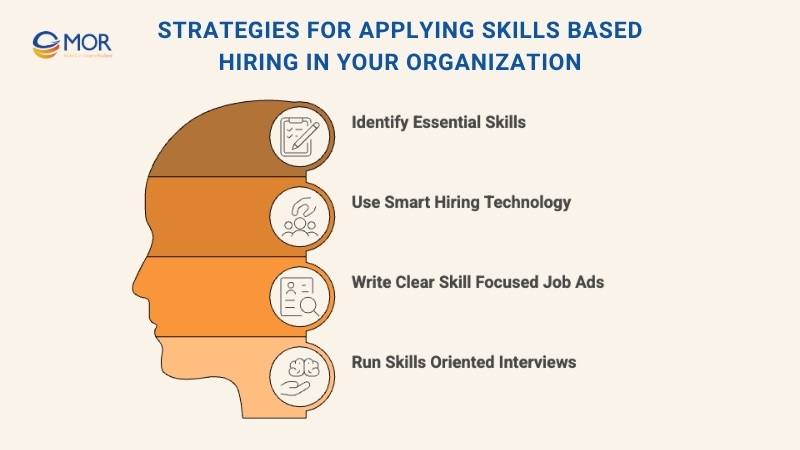
Identify Essential Skills
The first step is to list the main skills your ideal candidate should have, because you must know what you want to measure. Think of it like creating a checklist for the right hire. Instead of asking, “What degree should they have?” start asking, “What skills are needed for this job?”
- Break Down Role Tasks: Look closely at what the job requires. For example, when hiring a digital marketer, focus on skills like SEO, analytics, and copywriting instead of asking for a marketing degree.
- Talk To Your Team: You can learn a lot about a role by asking current team members which skills they use every day.
- Use A Competency Framework: A competency framework shows the skills, knowledge, and strength needed for a job. It acts like a guide for recruiters. Systems like the Skills Framework for the Information Age (SFIA) help define skills for technical roles.
Use Smart Hiring Technology
Using technology in skills based hiring is important. The right tools help make the process smoother, more accurate, and better at reducing bias.
- Pre Employment Assessment Tests: Online assessment tests help employers measure skills, knowledge, and job fit from anywhere. These standard tools run on a candidate assessment platform and include psychometric tests, situational judgment tests, video interviews, and more. Working with a trusted provider ensures a smooth and reliable experience.
- Gamified Assessments: Game based assessments use game style elements to review skills, personality traits, and thinking ability in a fun and interactive way. These tools make the hiring process more engaging, precise, and welcoming to different types of candidates.
- Skill Focused ATS: An Applicant Tracking System helps filter people who do not meet job needs. In a skills based hiring approach, you can set the ATS to sort and rank candidates based on skills. This creates a more focused and clear selection process.
Write Clear, Skill Focused Job Ads
When you use skills based hiring in your process, it helps to remove strict degree requirements when possible, especially for roles where proven skills matter more. A clear job description sets the direction for the whole hiring process and attracts people with the right abilities.
- Prioritize Skills: List the technical skills, soft skills, and transferable skills needed for the role instead of asking for degrees or long experience. This helps you reach a wider group of candidates.
- Highlight Performance Goals: Explain what good results look like in the job. For example, “Deliver three strong marketing campaigns within six months.”
- Clarify The Assessment Process: Let candidates know that skills tests or work simulations will be used. This sets clear and honest expectations from the start.
Run Skills Oriented Interviews
Interviews are an important part of the hiring process and work well when paired with pre screening assessments. When using skills based hiring, the interview should center on a candidate’s real ability.
- Structured Interviews: Use the same set of questions for all candidates to check job related skills and keep the process consistent.
- Behavioral Questioning: Ask candidates to share real examples of how they used key skills. For example, “Describe a time you solved a technical issue under a tight deadline.”
- Practical Exercises: Add tasks that reflect daily work, such as coding tasks, case studies, or role play for customer service.
- Panel Interviews: Invite different team members to join the interview. This helps minimize bias and gives a fuller view of the candidate’s ability.
Research from Harvard Business School shows that degree holders often have shorter retention in companies.
Ready to see who is leading this shift? The next section looks at real world examples of organizations using skills based hiring and how it improves their results.
Which Industries Are Using Skills Based Hiring?
Many major industries around the world now use skills based hiring to solve talent shortages, reduce bias, and improve workforce diversity. This approach also helps organizations stay competitive in a fast changing global market.
Industries Using Skills Based Hiring
Some industries benefit greatly from skills based hiring, while others still require formal training, degrees, or certifications such as medicine or law. Below are the industries that gain the most from a skills first approach.
- Technology and IT: The tech industry was one of the earliest to adopt skills based hiring because most roles need hands on skill with tools, coding languages, or technical frameworks. Large tech companies like Google and Microsoft look for people who can adapt fast and show real ability, since technology changes quickly and static classroom knowledge is not enough.
- Retail and Customer Service: These fields rely heavily on soft skills such as communication, problem solving, and teamwork. Employers like Walmart and Concentrix focus on how well a candidate can support customers and manage daily challenges for roles like retail staff and store leads.
- Creative Industries: Design, content creation, and digital marketing value portfolios and real results over formal education. Companies such as Walt Disney look at creative output and skill quality to judge fit.

- Healthcare Support Roles: Doctors and surgeons need degrees and licenses, but support and administrative roles often do not. Organizations like NHS and Cleveland Clinic use skills tests to hire for medical technician, admin, and operations roles.
- Manufacturing and Skilled Trades: Fields like automotive, construction, and machining rely on practical skill. Siemens and similar companies use certifications and hands on tests to check if candidates can perform job tasks safely and correctly.
- Finance and Consulting: Companies need strong skills like financial analysis, problem solving, and adaptability. Major consulting firms, including Deloitte, PwC, EY, and KPMG, often use case studies and task based exercises to review candidates through skills based hiring.
Even though this approach works well across many industries, some industries cannot fully depend on skills based hiring.
Industries That Cannot Fully Depend On Skills Based Hiring
Some industries cannot fully depend on skills based hiring because formal education and strict credentials are required. These fields follow more traditional hiring steps and place strong weight on verified qualifications. Here are the sectors where this applies:
- Medicine: In healthcare, formal education, licenses, and certifications are essential. A doctor, surgeon, or pharmacist must complete many years of academic study and clinical training to protect patient safety. Each role requires deep knowledge and precise practice that can only be gained through structured education and standardized testing.
- Law: Legal work requires advanced degrees, bar certification, and detailed understanding of local laws. Skills based hiring cannot replace these conditions. Practicing law demands solid knowledge of legal rules, processes, and ethics, which comes from formal study and approved training.
- Engineering (Certain Specializations): Some areas of engineering accept skills based hiring, but fields such as civil engineering or aerospace engineering often require formal degrees and licenses. These roles must follow safety rules and engineering standards. Public safety and large infrastructure depend on validated expertise supported by accredited education.
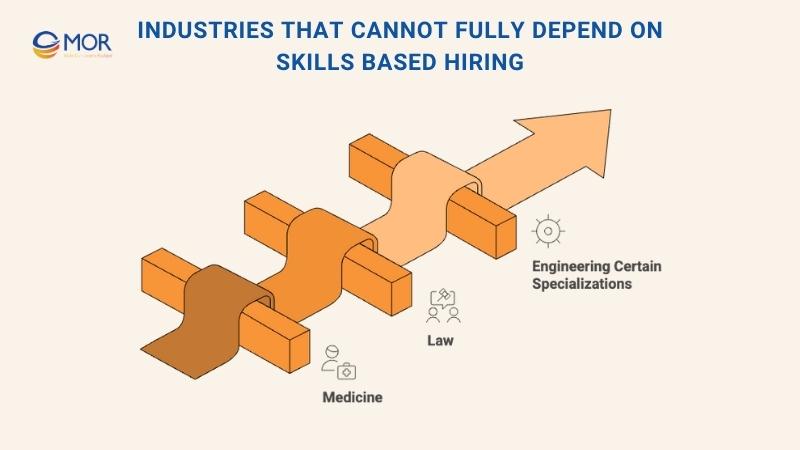
Next, we will explore the top employers that use a skills based recruitment approach in their hiring programs.
Leading Companies Using Skills Based Hiring
We’ve highlighted some of the strongest examples of organizations that have embraced this approach. Let’s look at how they apply it in real hiring situations.
Google is one of the earliest companies to rethink how hiring should work. The company noticed that traditional qualifications do not always match real job performance, so it removed degree requirements for many positions. Google now places strong focus on technical ability and problem solving skills. Through its Google Career Certificates, the company also offers training in areas like IT support, data analysis, and project management. These programs help people without degrees gain the skills needed to qualify for entry level roles.
IBM
IBM’s “New Collar” jobs program is one of the strongest examples of skills based hiring in action. The company hires people for roles such as cybersecurity analysts and cloud developers based on real ability instead of degrees. IBM works with community colleges and coding boot camps to help train new talent, which supports a more inclusive workforce. Today, IBM shares that 15 percent of its technical hires in the United States come from non traditional education paths.
EY (Ernst & Young)
EY, one of the Big Four accounting firms, removed degree requirements for entry level jobs in 2016. The company now relies on skills assessments and structured interviews to understand each candidate’s potential. EY believes that academic results do not always predict success in real work.
Tesla
Tesla chooses candidates based on their real ability to perform, not their education history. Elon Musk has shared that “there’s no need to have a college degree… if someone has the skills, they can do the job.” Tesla often uses technical tasks and hands on challenges to evaluate applicants, especially for engineering roles.
As a company that promotes skills first recruitment, LinkedIn follows the same approach in its own hiring. The company highlights skills like communication, project management, and adaptability in job ads. LinkedIn’s Skills Assessments help both candidates and recruiters match expectations, which makes the hiring process clearer and more efficient.
Deloitte
Deloitte supports a “skills over degrees” mindset, especially for consulting and technical roles. The company uses competency based evaluations to find candidates with strong problem solving and leadership skills. Deloitte also applies situational judgment tests and case study tasks to check real world ability during the hiring process.
PwC (PricewaterhouseCoopers)
PwC uses a skills based hiring approach to fill roles that need strong digital and analytical ability. The company also offers training through its Digital Accelerator program to help employees stay ready for future changes. PwC includes gamified assessments in its hiring process to review problem solving and creative thinking.
Starbucks
Starbucks applies a skills first method, especially for management positions. The company focuses on soft skills such as leadership, communication, and teamwork when reviewing candidates. Managers are chosen for their ability to build a positive team atmosphere and deliver strong customer experiences, even if they do not have formal qualifications.
Apple
Apple uses a skills based hiring approach for many technical roles in software and hardware engineering. The company reviews candidates through coding challenges and design focused tasks to check real ability. Tim Cook shared that almost half of Apple’s U.S. employees in 2023 did not hold a four year degree.
Popular Roles Recruited With Skills Based Hiring
Here are the common roles that employers often fill through skills based hiring, with a short explanation of why each role fits this approach well.
- Data Analyst: Data analysts are hired for their ability to work with numbers, study trends, and explain insights clearly. Companies look for strong analytical thinking, knowledge of tools like Excel or SQL, and the skill to turn data into useful information.
- Social Media Manager: This role depends on creativity, content planning, and an understanding of online behavior. Employers focus on real examples of social media work, campaign results, and the ability to manage different platforms.
- Accountant: Accountants are hired for accuracy, financial knowledge, and skill with accounting tools. Skills based hiring helps companies check attention to detail, problem solving, and knowledge of reporting standards.
- UI/UX Designer: These designers must show skill in creating easy to use layouts and smooth user experiences. Companies look at design portfolios, wireframes, and problem solving in real user scenarios.
- Digital Marketing Executive: This role needs knowledge of SEO, paid ads, analytics, and content strategy. Employers often choose candidates who can show past campaign results or explain digital marketing steps clearly.
- Investment Banker: This job requires strong skills such as financial modeling, analysis, and fast decision making. Companies use case studies and problem tasks to check accuracy and strategic thinking.
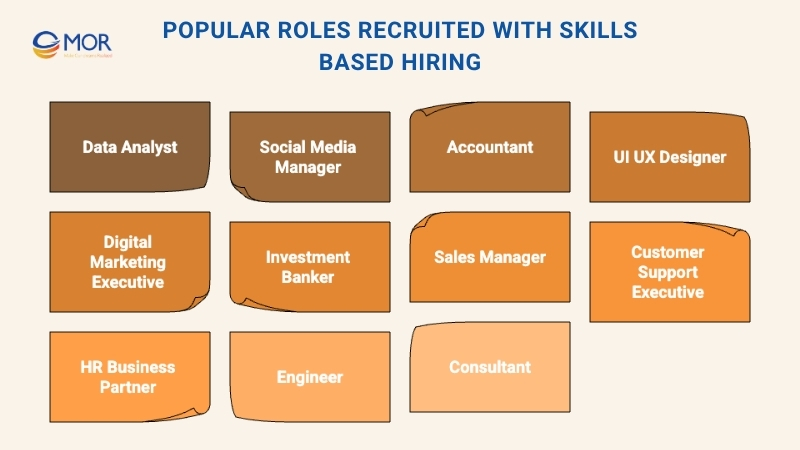
- Sales Manager: Sales managers must show leadership, communication, and the ability to grow revenue. Skills based hiring helps check real sales results, negotiation skills, and team guidance.
- Customer Support Executive: Support roles rely on communication, patience, and problem solving. Employers check how candidates handle customer issues and how well they manage tough situations.
- HR Business Partner: This position requires skill in communication, conflict handling, and planning. Companies often look for people who can give real examples of working with teams and solving people related issues.
- Engineer: Engineers are hired for their technical skill and ability to handle real world tasks. Skills based hiring uses tests or simulations to review problem solving and practical knowledge.
- Consultant: Consultants need strong analytical ability, communication, and the skill to solve complex business challenges. Employers check presentation skills, case study performance, and structured thinking.
Now we can explore what the future of skills based hiring may look like and how it will shape recruitment in the coming years.
What Is The Future Of Skills Based Hiring?
Skills based hiring is reshaping traditional recruitment as more organizations choose ability over formal credentials. This shift shows a major change in how companies find, measure, and select talent in a fast moving workplace. When employers focus on competencies instead of degrees or job titles, they open access to a wider and more diverse group of candidates. This also helps companies stay prepared for changing workforce needs. It aligns with skills-based workforce planning, which supports long term growth.
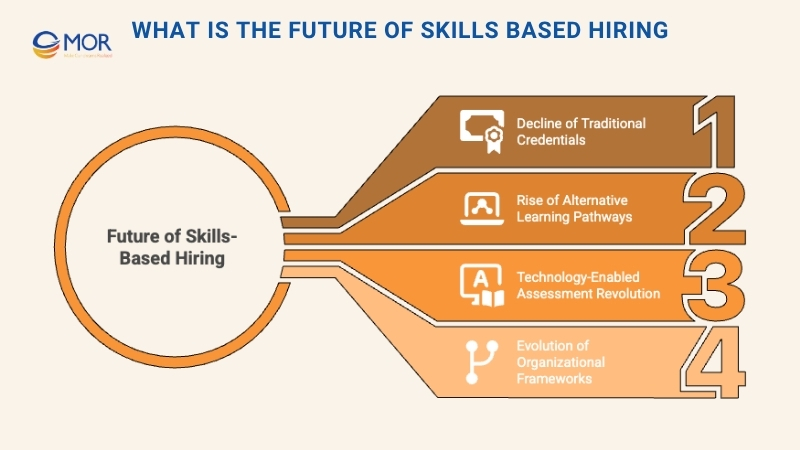
Let us look at the key parts of this change and what skills based hiring means for the future of work.
The Decline Of Traditional Credentials
The long held importance of academic credentials is fading as companies see that degrees are not always the best sign of real ability. Tech leaders like IBM, Apple, and Google have already removed degree requirements for many roles and now focus strongly on skills based recruitment. This change highlights the value of practical skill in today’s work environment compared to formal education alone.
A Harvard Business School study (2023) reported that:
- Roles that removed degree requirements were filled 37 percent faster than roles that kept them
- Forty five percent of middle skill positions now show signs of “degree deflation”
- Companies that dropped degree requirements saw a 58 percent increase in their candidate pool
The Rise Of Alternative Learning Pathways
The growth of new learning options has played a major part in speeding up the move toward skills based hiring. Programs such as boot camps, Massive Open Online Courses (MOOCs), and micro credentials give people clear and accessible ways to build skills outside of traditional universities. These learning paths often provide practical, focused training that matches what industries actually need. They help learners move quickly into jobs where hands on ability matters more than formal degrees.
The fast rise of alternative learning choices can be seen in recent data:
- Coursera reported 92 million registered learners in 2023, a 40 percent increase from 2021
- EdX recorded an 85 percent growth in micro credential completions between 2021 and 2023
- Boot camp enrollment increased 30 percent each year from 2019 to 2023 (Course Report, 2023)
Technology Enabled Assessment Revolution
Modern technology has changed how companies measure candidate ability. New digital platforms make it possible to review skills with very high accuracy through science based testing. Tools such as pre employment assessments, game based assessments, video interviews, virtual simulations, and assessment centers give employers a full view of both practical and soft skills. These tools support clear decision making and help teams choose talent based on real performance, not assumptions.
Findings from Gartner’s 2023 HR Technology Survey show the scale of this shift:
- 63 percent of organizations now use AI powered skills assessment tools
- 47 percent plan to increase their spending on skills based technology
- 82 percent report better hiring accuracy with skills focused assessment tools
The Evolution Of Organizational Frameworks
Many forward looking companies are building detailed skills frameworks that break each role into clear and measurable competencies. This structured method helps hiring teams match candidates to jobs with greater accuracy. It also gives employees a clear path for growth, showing which skills they need to build at each stage of their career. This approach supports long term planning and helps organizations stay flexible as job needs change.
A Deloitte survey (2023) of companies using skills based hiring revealed:
- 72 percent reported stronger diversity across their teams
- 68 percent saw better overall job performance
- 59 percent experienced higher employee satisfaction
Now we can close our discussion on skills based hiring with a quick look at what companies can expect in the years ahead.
Key Takeaways For Recruiters
Looking ahead, skills based hiring is expected to become the main method for finding and keeping strong talent. Companies that adjust early will gain an advantage in attracting, developing, and retaining skilled employees.
Skills based hiring is not only a new hiring style. It is a shift in how we understand careers, skill growth, and long term development. As technology continues to reshape jobs and career paths become less direct, building real skills will matter for both employers and workers.
The success of this shift will depend on how well companies use the benefits of a skills first model while managing the challenges that come with it. Organizations that apply this approach effectively will build flexible and skilled teams ready to meet the demands of the modern workplace.

At MOR Software JSC, we use a skills based mindset as a core part of how we hire and grow our teams. Instead of relying only on formal qualifications, we focus on real ability, adaptability, and strong results in practical work. Our hiring process looks for people who show technical strength, creative problem solving, and teamwork. This helps us build teams that meet global standards and deliver value across many industries.
If you want to work in a place that values your real skills, join MOR Software and grow your career with us. Contact us today to explore new opportunities.
Conclusion
Skills based hiring is shaping the future of recruitment as more companies rely on proven ability instead of traditional credentials. This approach helps teams stay flexible, improve accuracy, and build a stronger workforce. As job needs continue to shift, focusing on real skills will be key for long term success. If you want to grow your career in a place that values real talent, MOR Software would love to meet you. Contact us today and explore your next opportunity with us.
MOR SOFTWARE
Frequently Asked Questions (FAQs)
What is skills based hiring?
Skills based hiring is a recruitment approach that evaluates candidates based on their actual abilities, competencies, and performance in job-related tasks. Instead of relying on degrees or past titles, employers assess whether candidates can demonstrate the practical skills needed for the role.
What is a skill based job?
A skill based job emphasizes what an employee can do rather than what formal qualifications they hold. These roles value demonstrated experience, technical knowledge, and problem-solving ability over academic background or previous job labels.
What is a skills based hiring platform?
A skills-based hiring platform is a digital system that helps employers define role-specific skills, create structured interview processes, and evaluate candidates through standardized assessments. These platforms often integrate tools for testing, scoring, and tracking skills throughout the hiring process.
What are the main benefits of skills based hiring?
This approach broadens the talent pool, speeds up recruitment, and improves employee performance. It also reduces bias, increases diversity, and boosts retention by ensuring candidates are matched to roles that fit their proven strengths.
How does skills based hiring differ from traditional hiring?
Traditional hiring often prioritizes degrees, resumes, and previous job titles. Skills-based hiring, on the other hand, focuses on demonstrated competence through practical tests, simulations, or work samples, helping identify talent that might otherwise be overlooked.
What types of skills are evaluated in skills based hiring?
Employers typically assess both technical and soft skills. Technical skills include things like coding, data analysis, or engineering, while soft skills cover communication, teamwork, adaptability, and leadership.
What challenges do companies face with skills based hiring?
Some challenges include defining measurable skills for each role, developing valid assessments, and managing the initial setup time and cost of the process. Over time, however, these investments usually lead to better-quality hires and lower turnover.
Is skills based hiring suitable for every industry?
Not always. While it works well in tech, creative, and customer-focused fields, some professions, like medicine or law, still require formal education and licensing. Even in those cases, assessing practical skills alongside credentials can enhance hiring quality.
Rate this article
0
over 5.0 based on 0 reviews
Your rating on this news:
Name
*Email
*Write your comment
*Send your comment
1